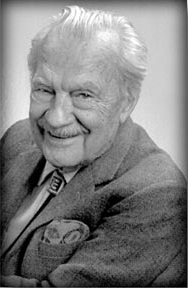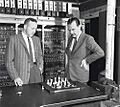Nicholas Metropolis facts for kids
Quick facts for kids
Nicholas Metropolis
|
|
|---|---|
 |
|
| Born |
Nicholas Constantine Metropolis
June 11, 1915 |
| Died | October 17, 1999 (aged 84) Los Alamos, New Mexico, United States
|
| Alma mater | University of Chicago |
| Known for |
|
| Awards | Computer Pioneer Award (1984) |
| Scientific career | |
| Fields | Physicist, Mathematician |
| Institutions | Los Alamos National Laboratory |
Nicholas Constantine Metropolis (born June 11, 1915 – died October 17, 1999) was a Greek-American physicist. He was also a talented mathematician. He is best known for his work on the Monte Carlo method, which uses random numbers to solve complex problems.
Metropolis earned his degrees in physics from the University of Chicago. He was recruited by Robert Oppenheimer to work on the Manhattan Project during World War II. Later, he led a team that built some of the earliest computers, like the MANIAC I.
Contents
Early Life and Education
Nicholas Metropolis was born in Chicago, USA, on June 11, 1915. He studied at the University of Chicago, where he earned his bachelor's degree in 1936 and his PhD in chemical physics in 1941. During his studies, he worked with famous scientists like Robert Mulliken.
After finishing his education, Metropolis became an instructor at the University of Chicago. In 1943, Robert Oppenheimer invited him to join the Manhattan Project in Los Alamos National Laboratory. This was a secret project to develop the first nuclear weapons.
At Los Alamos, Metropolis worked with other brilliant minds, including Richard Feynman. They focused on creating "electromechanical devices" to help with calculations. These were early forms of computing machines.
Building Early Computers
After World War II, Nicholas Metropolis returned to the University of Chicago as a professor. However, he soon went back to Los Alamos in 1948. There, he took charge of a team in the theoretical division.
His team designed and built two important early computers: the MANIAC I in 1952 and the MANIAC II in 1957. The MANIAC I was based on another early computer called the IAS machine. Metropolis chose the name "MANIAC" hoping to stop others from using similar acronyms for their machines.
From 1957 to 1965, he was a full professor of physics at the University of Chicago. He also helped start the university's Institute for Computer Research. In 1965, he returned to Los Alamos permanently.
What is the Monte Carlo Method?
One of Nicholas Metropolis's most important contributions was helping to develop the Monte Carlo method. This happened at Los Alamos in the late 1940s and early 1950s. He worked with other scientists like John von Neumann and Stanislaw Ulam.
The Monte Carlo method is a way to solve problems using repeated random sampling. Think of it like rolling dice many, many times to find an answer. It's named after the famous casinos in Monte Carlo because it uses randomness.
Metropolis was involved in the very first use of this method. In 1948, he helped rewire the ENIAC computer. This allowed it to run simulations of a nuclear core using the Monte Carlo method.
In 1953, Metropolis co-wrote a key paper called Equation of State Calculations by Fast Computing Machines. This paper showed the first computer simulations of a liquid. It also introduced a new way to use the Monte Carlo method for these calculations.
How the Monte Carlo Method Works
Before Metropolis's work, scientists would randomly create many possible arrangements of a system. Then, they would calculate properties for each arrangement. Finally, they would average these results.
The big idea from Metropolis's paper was to choose arrangements that were more likely to happen. They did this by using a special probability based on the system's energy. This made the calculations much more efficient.
This method for generating samples was later improved by W.K. Hastings. Today, it is widely known as the Metropolis–Hastings algorithm. It is used in many fields, from physics to finance.
Awards and Recognition
Nicholas Metropolis was a respected member of several important scientific groups. These included the American Academy of Arts and Sciences and the American Physical Society.
In 1987, he was the first Los Alamos employee to be given the title "emeritus" by the University of California. He also received the Pioneer Medal from the Institute of Electrical and Electronics Engineers.
Today, the American Physical Society gives out the Nicholas Metropolis Award every year. This award recognizes excellent doctoral thesis work in computational physics.
A Scientist on Screen
Nicholas Metropolis even had a small acting role! He played a scientist in the 1992 Woody Allen film Husbands and Wives.
Personal Life
Nicholas Metropolis had a son named Christopher and two daughters, Penelope and Katharine. He enjoyed staying active. He was an enthusiastic skier and tennis player well into his seventies. He passed away in Los Alamos, New Mexico.
Fun Stories
Stanislaw Ulam, another famous scientist, shared some fun stories about Metropolis in his memoirs. He recalled that a group of scientists, including Metropolis and John von Neumann, used to play poker at Los Alamos.
Metropolis once described how proud he was to win ten dollars from John von Neumann. Von Neumann was famous for writing a book on game theory. Metropolis then bought von Neumann's book for five dollars and taped the other five inside the cover. It was a symbol of his victory!
Ulam also described Metropolis as "a Greek-American with a wonderful personality."
Images for kids
-
Metropolis's wartime Los Alamos National Laboratory badge photo.
See also
 In Spanish: Nicholas Metropolis para niños
In Spanish: Nicholas Metropolis para niños




